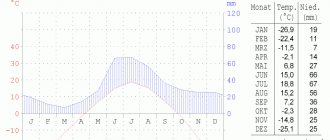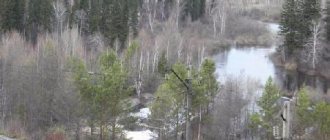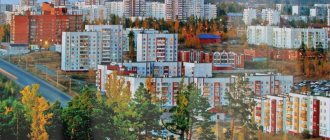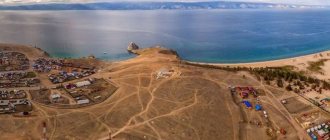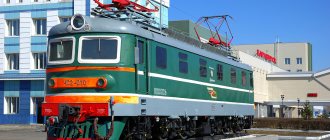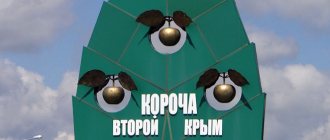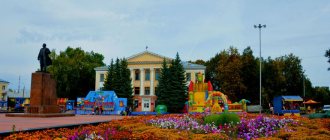Story
The first mention of the city of Winter is contained in the materials of the Central State Archive of Ancient Acts - “Revision Tales” of the mid-18th century. In August 1743, the Irkutsk provincial chancellery ordered the creation of a station on the Great Moscow Road. Prisoners were driven along this road in the mid-18th century. Winter supposedly got its name from the Buryats: they called this place zeme
, which translated means
guilt, misconduct
.
The coachman Nikifor Matveev is considered the first inhabitant of Winter. “In the past 1743, by Decree of the Irkutsk Chancellery from the Bratsk prison, he, Matveev, was assigned to the Ziminsky camp as a coachman to maintain the supply chain... at a seven-kopeck salary.”
, - recorded in “Revision Tales”.
Throughout the second half of the 18th century and the entire 19th century, Zima developed as a tribal village near the tract. Builders and railroad workers, exiles, and prisoners settled in Zim. In 1878, the village was the center of the rural Ziminsky society, which included the Khulgunuy Zaimka and the village of Ukhtui. The city museum of local lore contains ancient photographs showing convicts building the railway, the arrival of the first steam locomotive "Rusak" in 1889, and a church car. These photographs were brought by the people of Zimino when the museum was opened in 1957.
In 1891, construction of the Trans-Siberian Railway began. The Zima station appeared, where a locomotive depot, railway workshops, and a residential village were built.
The settlement was given city status in 1917.
Today, the city of Zima is a city of regional subordination, the center of the administrative district of the Irkutsk region, a large supporting railway station of the East Siberian Railway.
On February 1, 1963 it was classified as a city of regional subordination. In January 1968, by resolution of the Presidium of the Irkutsk Regional Executive Committee, the draft city limits were approved.
Some events in the history of Winter
| First half of the 18th century | A settlement was founded on the banks of the Oka River at the confluence of the Zima River. |
| 1743 | In the statements “Revision Tales” an entry was made about the existence of the “Ziminsk Stanza” |
| 1772 | The Moscow highway was laid, turning Zima into a village near the highway |
| 1878 | The village of Zima became the center of the rural Ziminsky society, which included the Khulgunuiskaya zaimka and the nearby village of Ukhtui. |
| 1897 | On October 6, the first train arrived in Winter. |
| Since 1898 | Regular traffic on the Trans-Siberian Railway began. The Zima station was opened, a station, railway workshops and the first building of the locomotive depot were built. |
| 1906-1913 | During this period, the Stolypin agrarian reform was carried out. A large number of immigrants from various regions of European Russia arrive at Zima station. Their efforts began large-scale agricultural development of the lands adjacent to the Trans-Siberian Railway. Grain and timber cargo began to arrive from Zima station. |
| 1917 | The village of Zima receives city status. |
| 1933 | The poet Yevgeny Yevtushenko was born in Winter. |
| 1930-1941 | A meat processing plant and a large bakery, a butter factory, and new sawmills were built in the city. The population grew to 26.9 thousand people. |
| 1957 | Construction of the Ziminsky hydrolysis plant has begun. |
| 1959 | With the transfer of the section of the Eastern Railway from Zima to Slyudyanka to electric traction, the Zima station began to serve as a stronghold for the electrification of the Trans-Siberian Railway. A large locomotive depot for electric locomotives was opened here. The first boiler was launched at CHPP-3. |
| 1962 | The Ziminsky hydrolysis plant began producing products. |
| 1960-1970 | A reinforced concrete plant, a rosin extraction plant, a poultry farm and a garment factory were put into operation. |
| 1968 | Resolution of the Central Committee of the CPSU and the Council of Ministers of the USSR dated May 16, 1968 No. 383 was issued, which instructed the USSR Ministry of Chemical Industry to create a powerful chemical plant on the basis of the Ziminsky salt deposit. The construction of the Ziminsky chemical plant (as Sayansk-khimplast OJSC was then called) was entrusted to the USSR Ministry of Medium Machine Building. The resolution of the Irkutsk Regional Executive Committee approved new boundaries of the city limits, taking into account the tasks of the Ziminsky Chemical Plant. |
| 1980s | The population of Zima began to decrease due to the creation of a larger and more comfortable city of Sayansk in the neighborhood and the start of a chemical plant, where there were high wages. The first units of the Novoziminskaya CHPP were launched. |
| 2003 | The Ziminsky hydrolysis plant ceased to exist. |
| 2006-2009 | The demographic situation in the city has stabilized. The population is kept at the level of 34.0 - 34.1 thousand people. |
Read on Irkipedia:
- Ziminsky district // “Siberian Soviet Encyclopedia” (1929)
- Winter, city // “Siberian Soviet Encyclopedia” (1929)
- Winter // Great Soviet Encyclopedia, 3rd ed. (1969-78)
- Winter // “Historical Encyclopedia of Siberia” (2009)
- Zima uprising // “Historical Encyclopedia of Siberia” (2009)
- Ziminsk City Party Committee (Gorkom) (1963–1991)
- Ziminsk City Komsomol Committee (Gorkom) (1963–1991)
- Ziminskaya narrow gauge railway
- Mass grave of Cheremkhovo workers who died in the struggle for Soviet power, Zima
Excerpt characterizing Winter (station)
All historians agree that the external activities of states and peoples, in their clashes with each other, are expressed by wars; that directly, as a result of greater or lesser military successes, the political power of states and peoples increases or decreases. No matter how strange the historical descriptions are of how some king or emperor, having quarreled with another emperor or king, gathered an army, fought with the enemy army, won a victory, killed three, five, ten thousand people and, as a result, conquered the state and an entire people of several millions; no matter how incomprehensible it may be why the defeat of one army, one hundredth of all the forces of the people, forced the people to submit, all the facts of history (as far as we know it) confirm the justice of the fact that greater or lesser successes of the army of one people against the army of another people are the reasons or, according to at least significant signs of an increase or decrease in the strength of nations. The army was victorious, and the rights of the victorious people immediately increased to the detriment of the vanquished. The army suffered defeat, and immediately, according to the degree of defeat, the people are deprived of their rights, and when their army is completely defeated, they are completely subjugated. This has been the case (according to history) from ancient times to the present day. All Napoleon's wars serve as confirmation of this rule. According to the degree of defeat of the Austrian troops, Austria is deprived of its rights, and the rights and strength of France increase. The French victory at Jena and Auerstätt destroys the independent existence of Prussia. But suddenly in 1812 the French won a victory near Moscow, Moscow was taken, and after that, without new battles, not Russia ceased to exist, but the army of six hundred thousand ceased to exist, then Napoleonic France. It is impossible to stretch the facts to the rules of history, to say that the battlefield in Borodino remained with the Russians, that after Moscow there were battles that destroyed Napoleon’s army. After the Borodino victory of the French, there was not a single general battle, but not a single significant one, and the French army ceased to exist. What does it mean? If this were an example from the history of China, we could say that this phenomenon is not historical (a loophole for historians when something does not fit their standards); if the matter concerned a short-term conflict, in which small numbers of troops were involved, we could accept this phenomenon as an exception; but this event took place before the eyes of our fathers, for whom the question of life and death of the fatherland was being decided, and this war was the greatest of all known wars... The period of the 1812 campaign from the Battle of Borodino to the expulsion of the French proved that a won battle is not only not the reason for conquest, but not even a permanent sign of conquest; proved that the power that decides the fate of peoples lies not in the conquerors, not even in armies and battles, but in something else. French historians, describing the position of the French army before leaving Moscow, claim that everything in the Great Army was in order, except for the cavalry, artillery and convoys, and there was no fodder to feed horses and cattle. Nothing could help this disaster, because the surrounding men burned their hay and did not give it to the French. The won battle did not bring the usual results, because the men Karp and Vlas, who after the French came to Moscow with carts to plunder the city and did not personally show heroic feelings at all, and all the countless number of such men did not carry hay to Moscow for the good money that they They offered it, but they burned it. Let's imagine two people who went out to duel with swords according to all the rules of fencing art: fencing lasted for quite a long time; suddenly one of the opponents, feeling wounded - realizing that this was not a joke, but concerned his life, threw down his sword and, taking the first club he came across, began to swing it. But let us imagine that the enemy, having so wisely used the best and simplest means to achieve his goal, at the same time inspired by the traditions of chivalry, would want to hide the essence of the matter and would insist that he, according to all the rules of art, won with swords. One can imagine what confusion and ambiguity would arise from such a description of the duel that took place. The fencers who demanded fighting according to the rules of art were the French; his opponent, who threw down his sword and raised his club, were Russians; people who try to explain everything according to the rules of fencing are historians who wrote about this event. Since the fire of Smolensk, a war began that did not fit any previous legends of war. The burning of cities and villages, retreat after battles, Borodin’s attack and retreat again, abandonment and fire of Moscow, catching marauders, rehiring transports, guerrilla warfare - all these were deviations from the rules. Napoleon felt this, and from the very time when he stopped in Moscow in the correct pose of a fencer and instead of the enemy’s sword he saw a club raised above him, he never ceased to complain to Kutuzov and Emperor Alexander that the war was waged contrary to all the rules (as if there were some rules for killing people). Despite the complaints of the French about non-compliance with the rules, despite the fact that the Russians, people of higher position, seemed for some reason ashamed to fight with a club, but wanted, according to all the rules, to take the position en quarte or en tierce [fourth, third], to make a skillful lunge in prime [the first], etc. - the club of the people's war rose with all its formidable and majestic strength and, without asking anyone's tastes and rules, with stupid simplicity, but with expediency, without considering anything, it rose, fell and nailed the French until until the entire invasion was destroyed. And good for the people who, not like the French in 1813, having saluted according to all the rules of art and turning the sword over with the hilt, gracefully and courteously hand it over to the magnanimous winner, but good for the people who, in a moment of trial, without asking how they acted according to the rules others in similar cases, with simplicity and ease, pick up the first club he comes across and nail it with it until in his soul the feeling of insult and revenge is replaced by contempt and pity. One of the most tangible and beneficial deviations from the so-called rules of war is the action of scattered people against people huddled together. This kind of action always manifests itself in a war that takes on a popular character. These actions consist in the fact that, instead of becoming a crowd against a crowd, people disperse separately, attack one by one and immediately flee when they are attacked in large forces, and then attack again when the opportunity presents itself. This was done by the Guerillas in Spain; this was done by the mountaineers in the Caucasus; the Russians did this in 1812.
Geography
Located 230 km northwest of the regional center of Irkutsk, on the left bank of the Oka River.
The relief is a slightly sloping plain with a general drop of 0.5-3.0% towards the Oka River, heavily swamped, with a high groundwater level.
The soils in the city contain floating waters, subsoil aggressive waters, and in some places lenses of permafrost; in the southern part of the city there are highly podzolized soils. Seismicity - 6 points.
The climate is sharply continental, air temperature varies from −40-50°C in winter to +35-40°C in summer. The minimum possible temperature in winter is minus 55°C.
- Topographic map of square N-48-B (Winter, Irkutsk, Ust-Ordynsky)
- Environmental protection properties of plant communities in the Irkutsk-Ziminsk region (Atlas)
Suburban service by station
| Train no. | Driving route | Train no. | Driving route |
| Suburban | Winter — Irkutsk | Suburban | Irkutsk — Winter |
| Express | Winter — Irkutsk | Express | Irkutsk — Winter |
| Suburban | Winter - Tulun | Suburban | Tulun - Winter |
Transport
A large station of the East Siberian Railway, located on the Trans-Siberian Railway (4934 km from Moscow). Suburban communication with Irkutsk (to the east) and with Tulun (to the west). Bus service to Sayansk.
The federal highway “Baikal” passes near the city.
Distance from Zima to some cities, km
| City | Distance | |
| by rail | by road | |
| Sayansk | — | 25 |
| Cheremkhovo | 120 | 117 |
| Tulun | 139 | 133 |
| Usolye-Sibirskoye | 183 | 190 |
| Angarsk | 211 | 221 |
| Irkutsk | 250 | 265 |
| Nizhneudinsk | 256 | 256 |
| Alzamay | 348 | 346 |
| Slyudyanka | 376 | 377 |
| Baykalsk | 411 | 416 |
| Taishet | 419 | 413 |
| Biryusinsk | 432 | 426 |
| Vikhorevka | 688 | 337 |
| Ulan-Ude | 706 | 715 |
| Bratsk | 712* | 358 |
| Krasnoyarsk | 837 | 782 |
*To Anzebi station.
City infrastructure
Zima is built up with wooden one-story (with garden plots) and multi-story comfortable houses.
One-story buildings predominate in the central part of the city, in the villages of LDK and II Stroitel, and in the so-called Staraya Zima. About 40% of the city's housing stock is concentrated in these microdistricts. Blocks of multi-storey, fully equipped houses are located mainly in the eastern part of the city - in the villages of Zheleznodorozhny and Gidrolyzny.
There is also a patchy development of comfortable houses in the villages of LDK, II Stroitel, Sennoy, in the central and western parts of the city, in the Angarsky microdistrict.
The city continues to serve as a stronghold for the development of the territory adjacent to the Trans-Siberian Railway. It is inextricably linked with all the settlements of the Ziminsky region and is their historical, administrative and cultural center.3
Links[edit]
Notes[edit]
- ^ abc Charter of the Irkutsk region
- ^ abc "General Information". Ivanovo region . Retrieved September 3, 2022.
- ^ a b Federal State Statistics Service (2011). “All-Russian Population Census 2010. Volume 1" [All-Russian Population Census 2010, vol. 1]. All-Russian Population Census 2010 [All-Russian Population Census 2010]
. Federal State Statistics Service. - "26. The size of the permanent population of the Russian Federation by municipalities as of January 1, 2022". Federal State Statistics Service. Retrieved January 23, 2022.
- ^ abcd Law No. 49-OZ
- ^ abc Law No. 85-ounce
- Law No. 102-oz.
- "On the Calculation of Time". Official Internet portal of legal information
. June 3, 2011. Retrieved January 19, 2022. - Post office. Information and computing center of OASU RPO. ( Post office
).
Search for postal service objects ( postal Search for objects
) (in Russian) - ↑
Federal State Statistics Service of Russia (May 21, 2004).
“The population of Russia, the constituent entities of the Russian Federation as part of federal districts, urban settlements, settlements, settlements is 3 thousand or more people” [Population of Russia, its federal districts, federal districts, districts Urban settlements, rural settlements - administrative centers and rural settlements with a population of over 3,000] (XLS). All-Russian Population Census 2002
. - “All-Union Population Census of 1989. The actual population of union and autonomous republics, autonomous regions and districts, territories, negative phenomena, urban settlements and villages-rayon”, No. 45, April 24, 2009 (Legislative Assembly of the Irkutsk Region. Resolution No. 9 /5-ЗС dated April 15, 2009. Charter of the Irkutsk Region
as amended by Law No. 2-U dated December 14, 2022 “
On amendments to the Charter of the Irkutsk Region
. day following the ten-day period after the day of official publication.). - Legislative Assembly of the Irkutsk Region. Law No. 49-OZ of June 21, 2010 “On the administrative-territorial structure of the Irkutsk region,” as amended. Law No. 12-OZ of March 23, 2022 “On Amendments to Articles 25 and 33 of the Law of the Irkutsk Region “On the Administrative-Territorial Structure of the Irkutsk Region” and the Law of the Irkutsk Region “On Amendments to a Geographical Object and (or) on the Renaming of Geographical Objects " Came into force after the official date of publication. Published: “Regional”, No. 71, June 25, 2010 (Legislative Assembly of the Irkutsk Region. Law of June 21, 2010 No. 49-OZ “ On the administrative-territorial structure of the Irkutsk Region”
, As amended by the Law of March 23, 2022 No. 12-OZ.
On amendments to Articles 25 and 33 of the Law of the Irkutsk Region “On the Administrative-Territorial Structure of the Irkutsk Region” and the Law of the Irkutsk Region “On the Procedure for Considering the Assignment of Names to Geographical Objects and (or) Renaming of Geographical Objects". "
. Effective with day of official publication). - Legislative Assembly of the Irkutsk Region. Law No. 85-oz of December 16, 2004 “On the status and boundaries of the Ziminsky urban municipality of the Irkutsk region,” as amended. Law No. 14-OZ of March 24, 2011 “On the extension of the Law of the Irkutsk Region” On the status and boundaries of the Ziminsky urban municipality of the Irkutsk region “to the entire territory of the new subject of the Russian Federation - the Irkutsk Region and introducing changes to it.” Came into force on December 31, 2004, but not earlier than ten days from the date of official publication. Published: “East Siberian Truth”, No. 254–255, December 20, 2004 (Legislative Assembly of the Irkutsk Region. Law of December 16, 2004 No. 85-oz “ On the status and boundaries of the urban municipality of Ziminskoye, Irkutsk Region”).
with amendments introduced by Law No. 14-OZ of March 24, 2011 “
On expanding the validity of the Law of the Irkutsk Region “On the status and boundaries of the urban municipality of Ziminskoye of the Irkutsk Region” to the entire territory of the new subject of the Federation.”
Russian Federation - Irkutsk region - and on amendments to this Law . Valid from December 31, 2004, but not earlier than ten days after the official date of publication.).
Population
Population dynamics
| 1931 | 1939 | 1959 | 1967 | 1970 | 1979 | 1989 | 1992 | 1996 |
| 13 200 | 26 800 | 38 549 | 42 000 | 41 567 | 48 097 | 41 814 | 39 400 | 37 300 |
| 1998 | 2001 | 2002 | 2003 | 2005 | 2006 | 2007 | 2009 | 2010 |
| 36 900 | 35 900 | 34 899 | 34 900 | 34 400 | 34 100 | 34 000 | 34 093 | 32 508 |
| 2011 | 2012 | 2013 | 2014 | 2015 | 2016 | 2017 | 2018 | 2019 |
| 32 485 | 32 279 | 31 936 | 31 523 | 31 440 | 31 283 | 31 229 | 30 988 | 30 818 |
| 2020 | ||||||||
| 30 515 |
Economy
Railway transport enterprises form the basis of the city's economy: locomotive and carriage depots, track distances, communication distances, the Zima railway station of the Trans-Siberian Railway. Most of these enterprises have recently reported directly to Moscow and are part of the vertical of JSC Russian Railways.
Private enterprises in the sawmill and woodworking industry (more than thirty), based on a pre-existing reinforced concrete plant, LDK, as well as a number of small sawmills.
The chemical plant (formerly Ziminsky chemical) currently belongs to Sayansk.
The Okinskaya poultry farm is an integrated enterprise, one of the largest producers of eggs, poultry meat, grain, and livestock products (milk, meat) in the country - registered in the village of Ukhtui, Ziminsky district.
More than 10 housing and communal services enterprises provide utility services in the city, including Vodokanalservice, Vodosnabzhenie, Stoki, Communal Service, Zimateploenergo, Atoll, Orion, Vostochnaya Management Company and others. The Vodokanal and Teplovik enterprises provide heat and water supply to enterprises in the Ziminsky district and provide public services to the population. It has a fleet of vehicles, 18 boiler houses, 61 water towers, heating networks with a length of about 40 km, and a water pipeline with a length of 16.4 km.
Previously, there was a large industrial hub in the city - at the end of Sadovaya Street there were the Irkutsk Thermal Power Plant-3 (currently exists as the Ziminsky section of the Novo-Ziminskaya Thermal Power Plant, five boiler units and two turbines are not working, mothballed), the Ziminsky Hydrolysis Plant (almost completely dismantled), Ziminsky rosin extraction plant (completely dismantled, declared bankrupt in 1998), timber processing plant, reinforced concrete products plant (on the territory of the last two enterprises, wood sawing and shipment of lumber and round timber are currently carried out).
Social sphere
Educational institutions:
— 7 secondary schools; — lyceum; — 1 primary school–kindergarten; — 8 preschool institutions; — special (correctional) boarding school No. 6, Zima; — an orphanage for creativity, which includes 2 teenage clubs “Romantic” and “Rovesnik”; — Ziminsky railway technical school; — Ziminsky training and sports center ROSTO (DOSAAF).
Until 2022, there was an evening secondary school No. 2. The school building was declared unsafe and demolished.
Health care institutions:
- OGBUZ "Ziminsk City Hospital", - NUH "Nodal Clinic at Zima Station of JSC "Russian Railways", - outpatient clinics: four clinics, a dispensary, antenatal clinic.
There are nine pharmacies and one pharmacy (as of 2019).
Cultural institutions:
— Ziminsk children's music school; — Ziminsk children’s art school named after V.A. Bryzgalov; — Cinema and leisure (five creative groups and five club groups); — City House of Culture “Horizon” (16 creative groups, 1 structural unit “House of Crafts” with 7 clubs and 3 club formations); — Cultural and informational (eight creative groups). — Museum of History and Local Lore; — House-Museum of Poetry; — Family Reading Library named after. N. Voinovskaya with two branches.
Facilities for mass physical education and sports:
The city’s sports base is represented by the municipal institution of additional education for children “Children and Youth Sports School named after G.M. Sergeev", which includes:
- ski resort "Yunost"
- Lokomotiv Stadium",
- weightlifting hall,
- boxing hall,
- chess club.,,3
Long-distance travel to the station
As of July 2016, the following trains pass through the station:
Year-round train service
| Train no. | Driving route | Train no. | Driving route |
| 1 "Russia" | Vladivostok — Moscow | 2 "Russia" | Moscow — Vladivostok |
| 3 | Beijing — Moscow | 4 | Moscow — Beijing |
| 5 | Ulaanbaatar — Moscow | 6 | Moscow — Ulaanbaatar |
| 7 | Vladivostok — Novosibirsk | 8 | Novosibirsk — Vladivostok |
| 11 | Chita — Chelyabinsk | 12 | Chelyabinsk — Chita |
| 19 "East" | Beijing — Moscow | 20 "East" | Moscow — Beijing |
| 43 | Khabarovsk — Moscow | 44 | Moscow — Khabarovsk |
| 57 | Irkutsk — Kislovodsk | 58 | Kislovodsk — Irkutsk |
| 69 | Chita — Moscow | 70 | Moscow — Chita |
| 71 | Ulan-Ude — Severobaykalsk | 72 | Severobaykalsk — Ulan-Ude |
| 77 | Neryungri — Novosibirsk | 78 | Novosibirsk — Neryungri |
| 81 | Ulan-Ude — Moscow | 82 | Moscow — Ulan-Ude |
| 87 | Irkutsk — Ust-Ilimsk | 88 | Ust-Ilimsk — Irkutsk |
| 99 | Vladivostok — Moscow | 100 | Moscow — Vladivostok |
| 107 | Vladivostok — Novokuznetsk | 108 | Novokuznetsk — Vladivostok |
| 133 | Vladivostok — Penza | 134 | Penza — Vladivostok |
Seasonal train traffic
| Train no. | Driving route | Train no. | Driving route |
| 205 | Irkutsk — Anapa | 206 | Anapa — Irkutsk |
| 241 | Irkutsk — Adler | 242 | Adler — Irkutsk |
| 269 | Chita — Adler | 270 | Adler — Chita |
